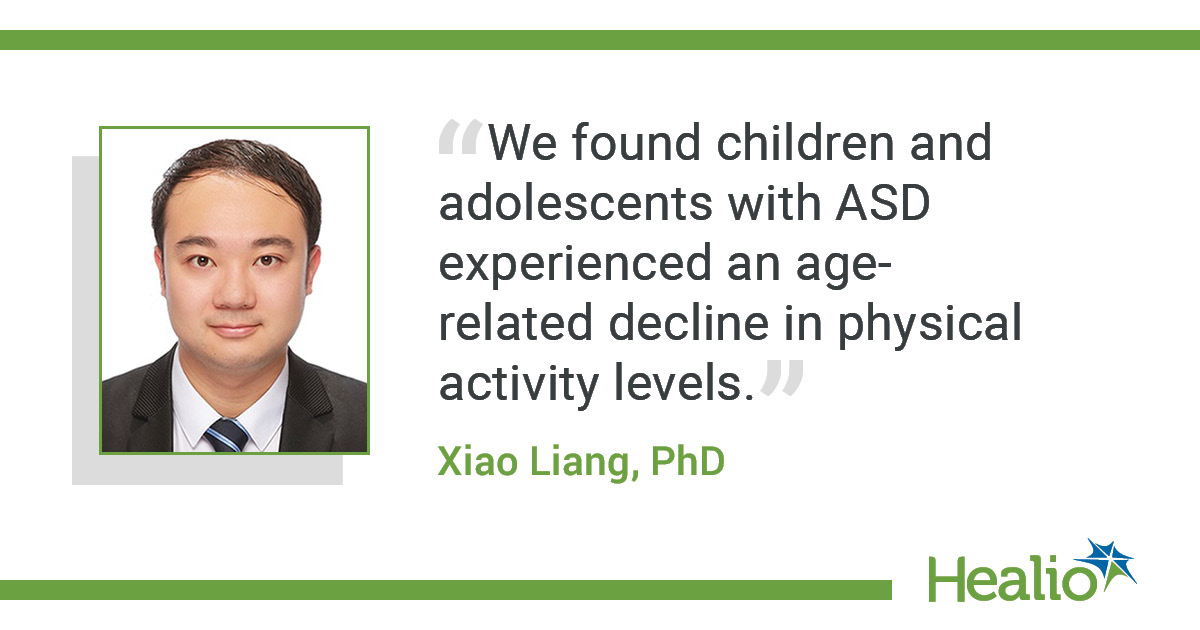Add topic to email alerts
Added to email alerts
Key takeaways:
Children with autism spectrum disorders had worse sleep and lower levels of physical activity than their peers, a study published in JAMA Network Open found.
One of the study’s authors told Healio that the investigation was prompted not only by results from one of his early studies but also by his experience as a registered inclusive education teacher in Hong Kong.
“I found that compared to students without [autisim spectrum disorder (ASD)], students with ASD had low physical activity levels during the [physical education] class, recess and lunch break,” said Xiao “Shawn” Liang, PhD, a research assistant professor in the department of rehabilitation sciences at Hong Kong Polytechnic University and co-author of the study.
In the first year of his study for his doctorate, Liang conducted a systematic review to summarize accelerometer-measured physical activity levels in children and adolescents with ASD, and he looked for barriers and facilitators to promote physical activity behaviors.
“This study found only 47% of children and adolescents with ASD met the WHO-recommended physical activity guidelines,” Liang said. “Still, we did not compare the physical activity levels with their typically developing peers.”
Liang continued that age-related declines in physical activity were evident in all children and adolescents globally.
“I would like to explore the differences in physical activity and sleep parameters in children and adolescents with and without ASD,” Liang said.
In the latest study, Liang and colleagues found 28 observational studies that assessed the differences in physical activity levels or sleep parameters between children and adolescents with and without ASD as part of a systematic review, encompassing 805 participants with ASD and 1,573 without, ranging from 5 to 16 years old. The researchers then calculated the effect sizes to represent the differences in physical activity levels and sleep parameters between children and adolescents with and without ASD. “Lastly, we performed the metaregression to explore the moderating effect of age on the differences in physical activity levels between these two groups,” Liang said.
Compared with peers without ASD, children and adolescents with ASD had lower physical activity levels, longer time in sleep latency, total sleep time and lower sleep efficiency.
The researchers did find a within-group difference in physical activity levels between weekdays and weekends among participants with ASD because children and adolescents with ASD spent more time in moderate-to-vigorous physical activity on weekdays (67.56 minutes per day) than on weekends (39.01 minutes per day). Most notably in the data, children and adolescents with ASD experienced an age-related decline in moderate-to-vigorous physical activity (=0.049 [95% CI, 0.097 to 0.001]; P=.045), indicating that younger children with ASD showed a smaller difference in MVPA compared with peers without ASD diagnoses.
The results “generally met” the researchers’ expectations, Liang said.
“We found children and adolescents with ASD experienced an age-related decline in physical activity levels,” Liang said. “We hope primary care providers and pediatricians can encourage children and adolescents to meet the minimum WHO-recommended daily physical activity guidelines to maintain health. In addition, physical activity intervention, as a promising nonpharmacological intervention, should be used to improve executive functions, sleep and problematic behaviors for children and adolescents with ASD.
Liang added that he hopes the study prompts further research on tailored physical activity interventions to help children and adolescents with ASD improve their functions and their sleep.
“I hope this research can call for more attention from the public on childhood psychiatric disorders,” Liang said. “We’re dedicated to addressing the physical inactivity and sleep disturbances in children and adolescents with ASD and ADHD and working toward good physical and mental health through physical activity interventions.”
Added to email alerts
This content was originally published here.
